Samsung Galaxy Nexus & Ice Cream Sandwich Review
by Brian Klug & Anand Lal Shimpi on January 18, 2012 1:34 PM ESTThe Galaxy Nexus - Hardware and Aesthetics
The evolution of Google’s Nexus line is an interesting one. Each year, Google choses both a silicon partner and an OEM to make a unique hardware archetype which it caters a specific build of Android to. We’ve now seen three Nexus handset designs from two OEMs and three silicon vendors - the Nexus One (HTC and Qualcomm’s QSD8x50), Nexus S (Samsung and Samsung’s S5PC110 ‘Hummingbird’), and today the Galaxy Nexus (Samsung and TI’s OMAP4460).
Looking at the hardware of those three handsets gives a great survey of the course the Android ecosystem has taken over the last couple of years. The Nexus One started things out with a 3.7” LCD, capacitive buttons, and hardware trackball. Nexus S then removed the trackball, added a curved 4.0” display, and ditched the microSD card slot. The Galaxy Nexus continues in that direction, increasing display size to 4.65” and resolution to 1280x720, and finally removing the capacitive buttons all together. Instead, the Galaxy Nexus uses a 96 x 720 region at the bottom of the display to visualize the navigational buttons, a move that has the consequence of also keeping the display interaction area aspect ratio close to that of WVGA.
It’s interesting to see how many of the design motifs set by the original Nexus One still have been thoughtfully preserved on the Galaxy Nexus. The notched chrome ring around the camera aperture has continued as a thread for three generations, as has the overall lightly rounded shape. The Galaxy Nexus also retains the chin from Nexus S backside where the speakerphone port and primary cellular antennas are located. In addition, the volume rocker, power/lock button, headphone jack, and primary microphone position from the Nexus S is unchanged.
The Galaxy Nexus’ backside is no longer the extremely slippery and scratch prone plastic that the Nexus S (and original Galaxy S) adorned, instead it’s a textured, lightly soft touch material. I’m always surprised by how much of a difference changing the backside texture makes on the overall in-hand feel impressions I come away with, and in this case it’s a major positive change. It’s clear that this is an evolution of Nexus more than a huge departure from what’s come before - if anything the Galaxy Nexus is like a larger, thinner, more refined Nexus S.
We’ve taken a look at both the CDMA/LTE (codename mysid/toro) and the GSM/UMTS (codename yakju/maguro) Galaxy Nexus variants.
The two differ beyond just the air interfaces they support slightly in the physical department as well, though the two share all the same other features (SoC, display, camera, etc.). The CDMA/LTE Galaxy Nexus is ever so slightly thicker than the GSM/UMTS Galaxy Nexus, though the difference is enough to be perceptible.
In addition, the two have the same exterior “titanium silver” color, no doubt the differences we saw earlier can be attributed to the difference between renders and the real deal. The other small detail is that the two use very different, non-interchangeable batteries - the GSM/UMTS variant uses a 6.48 Whr battery, the CDMA/LTE version gets a slightly larger 6.85 Whr battery. Both of these include the NFC antenna patterned the outside surface of the battery, just under the sticker.
Other than those subtle differences, Samsung has done a good job masking the challenges which underlie having two superficially similar phones with different cellular architectures. The two variants do feel different in the hand, but the difference isn't dramatic.
| Physical Comparison | ||||
| Apple iPhone 4S | Samsung Galaxy S 2 | Samsung Galaxy Nexus (CDMA/LTE) | Samsung Galaxy Nexus (GSM/UMTS) | |
| Height | 115.2 mm (4.5") | 125.3 mm (4.93") | 135.5 mm (5.33") | 135.5 mm (5.33") |
| Width | 58.6 mm (2.31") | 66.1 mm (2.60") | 67.94 mm (2.67) | 67.94 mm (2.67) |
| Depth | 9.3 mm ( 0.37") | 8.49 mm (0.33") | 9.47 mm (0.37") | 8.94 mm (0.35") |
| Weight | 140 g (4.9 oz) | 115 g (4.06 oz) | 150 g (5.3 oz) | 135 g (4.8 oz) |
| CPU | Apple A5 @ ~800MHz Dual Core Cortex A9 | 1.2 GHz Exynos 4210 Dual Core Cortex A9 | 1.2 GHz Dual Core Cortex-A9 OMAP 4460 | 1.2 GHz Dual Core Cortex-A9 OMAP 4460 |
| GPU | PowerVR SGX 543MP2 | ARM Mali-400 | PowerVR SGX 540 | PowerVR SGX 540 |
| RAM | 512MB LPDDR2-800 | 1 GB LPDDR2 | 1 GB LPDDR2 | 1 GB LPDDR2 |
| NAND | 16GB, 32GB or 64GB integrated | 16 GB NAND with up to 32 GB microSD | 32 GB NAND | 16/32 GB NAND |
| Camera | 8 MP with LED Flash + Front Facing Camera | 8 MP AF/LED flash, 2 MP front facing | 5 MP with AF/LED Flash, 1080p30 video recording, 1.3 MP front facing | 5 MP with AF/LED Flash, 1080p30 video recording, 1.3 MP front facing |
| Screen | 3.5" 640 x 960 LED backlit LCD | 4.27" 800 x 480 SAMOLED+ | 4.65" 1280x720 SAMOLED HD | 4.65" 1280x720 SAMOLED HD |
| Battery | Internal 5.3 Whr | Removable 6.11 Whr | Removable 6.85 Whr | Removable 6.48 Whr |



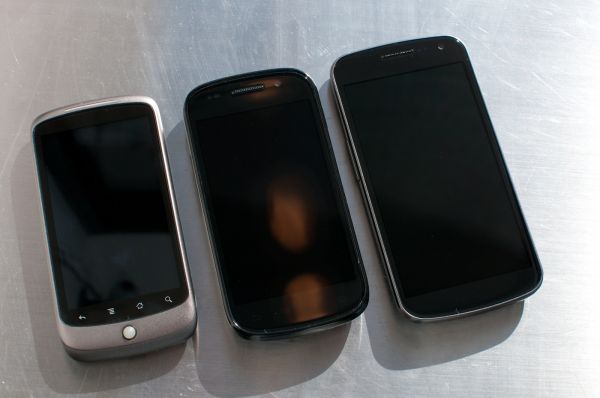
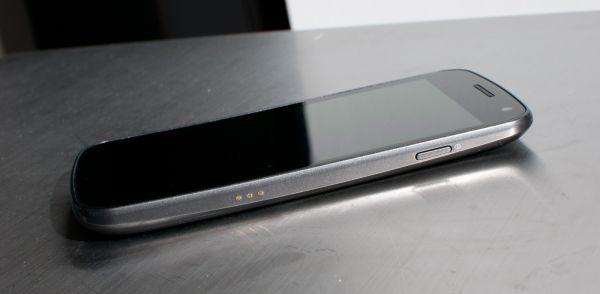
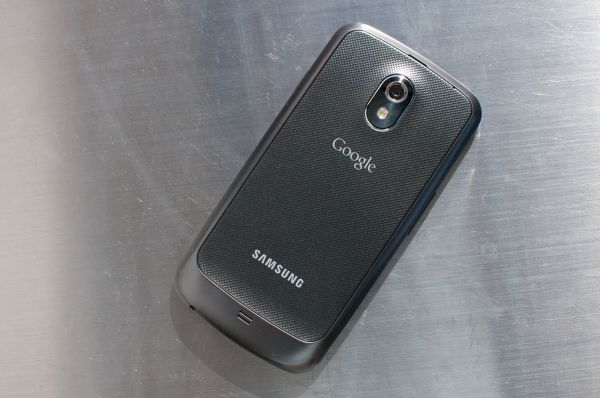
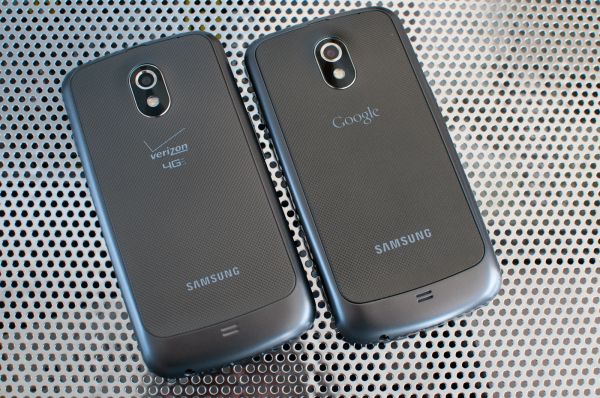
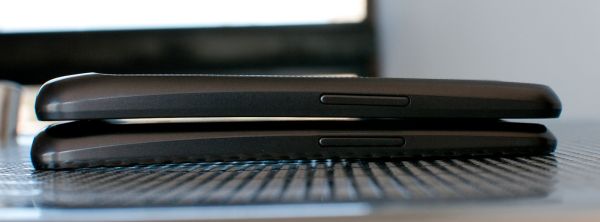














185 Comments
View All Comments
roedtogsvart - Wednesday, January 18, 2012 - link
Finally!prophet001 - Wednesday, January 18, 2012 - link
Just had one of this hit my desk today :D very nice phone.Owls - Thursday, January 19, 2012 - link
No offense but I'm kind of pissed after reading this article with what amounts to a masturbatory article about the iphone 4s.For example on an ipad 2 and iphone 4s there is plenty of lag here and there using the UI on par with gingerbread. On ICS? It's pratically nonexistent.
The camera? The only issue I found was that on Auto the shots didn't always come out great. Some manual adjustments fixed that and after comparing the shots to my dad's iphone 4s there's virtually no difference.
I pretty much stopped reading after the camera section.
michael2k - Thursday, January 19, 2012 - link
What kind of lag are you talking about? The A5 SoC is one of the most powerful out there and it's already been noted in several reviews how the older A4 SoC plus iOS 4 and 5 outperformed Gingerbread. You're saying the lag on ICS is somehow better than an A5 plus iOS 5 by saying the A5 + iOS 5 is as laggy as a CPU bound unaccelerated Android 2.3?medi01 - Friday, January 20, 2012 - link
Why, do you think, anand is using 720p "off-screen" in benchmarks, why not try it directly on screen?PS
Oh, and why "black levels" aren't present on screen comparison? And why iphones dissapear from charts where they are wtfpwned by other phones?
Sigh. Disgusting.
michael2k - Monday, January 23, 2012 - link
All the phones and tablets would go up in number if they used native resolution, but then you can't actually compare the HW because each would be constrained by different resolutions. By using 720p offscreen you get to judge all the HW on the same scale.Also, Anand has definitely reported black levels:
http://www.anandtech.com/Show/Index/4215?cPage=4&a...
I don't know of any places where the iPhone disappear so much as the iPhone doesn't run the app. You'll notice that the rankings appear congruent; 4S followed by S2 with the Nexus and 4 on the bottom. Nothing changes, except that certain apps aren't available for the iPhone. Rightware Basemark is an Android app, silly.
medi01 - Wednesday, January 25, 2012 - link
And "actual HW number" tells you what? That GPU X is faster than GPU Y? Instead of saying "phone X would render faster than phone Y"? How is first more appropriate mesurement than the latter?@Also, Anand has definitely reported black levels:@
Are you kidding me? Where is vs amoled comparison in your link? How is it related to the article in discussion?
Not only do they skip "black levels", they somehow manage to make a picture of AMOLED screen where BLACK looks GREY. Wow, great job misleading readers.
michael2k - Wednesday, January 25, 2012 - link
Yes, GPU X is faster than GPU Y is a perfectly valid comparison. You would have to ask Anand why he thought comparing GPUs was a valid benchmark, but given the long track record of how responsive the iPhone has been compared to Android, I don't see how that anything else is relevant. The fact that offscreen performance favors the iPhone 4S doesn't change that it doesn't favor the iPhone 4!Also, why would he compare to amoled when in fact there are no amoled tablets to compare to?
You're a baseless and pointless critic.
doobydoo - Thursday, January 19, 2012 - link
There is no lag at all on the iPad 2 or the iPhone 4S, what are you talking about?I think you're more pissed off that the Nexus came with an average camera and a 2-year-old GPU.
Lucian Armasu - Monday, January 30, 2012 - link
Well, iPhone 4 came with a 2 year old GPU, too in 2010, and much lower FPS than the competition, if you remember those GPU charts, where the iPhone 4 was the last at the bottom. Not too many people seemed to care about it.